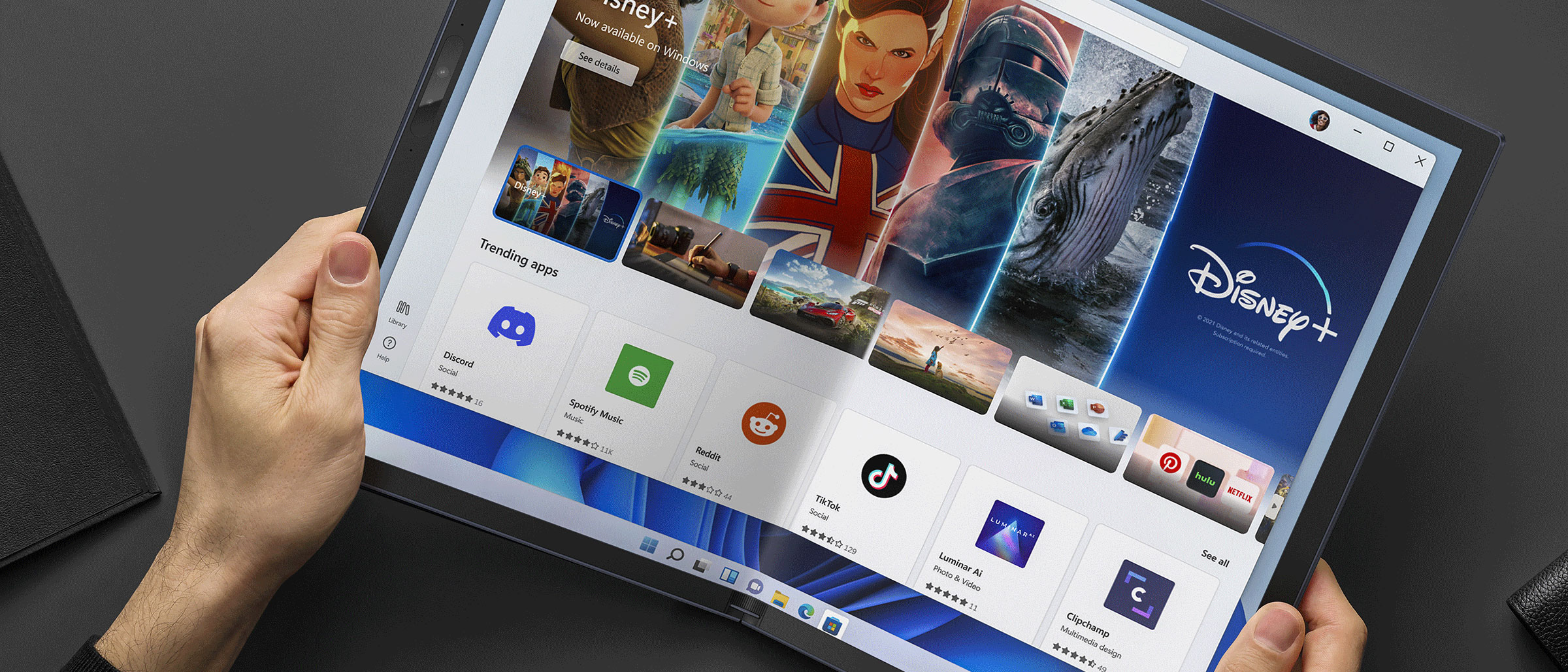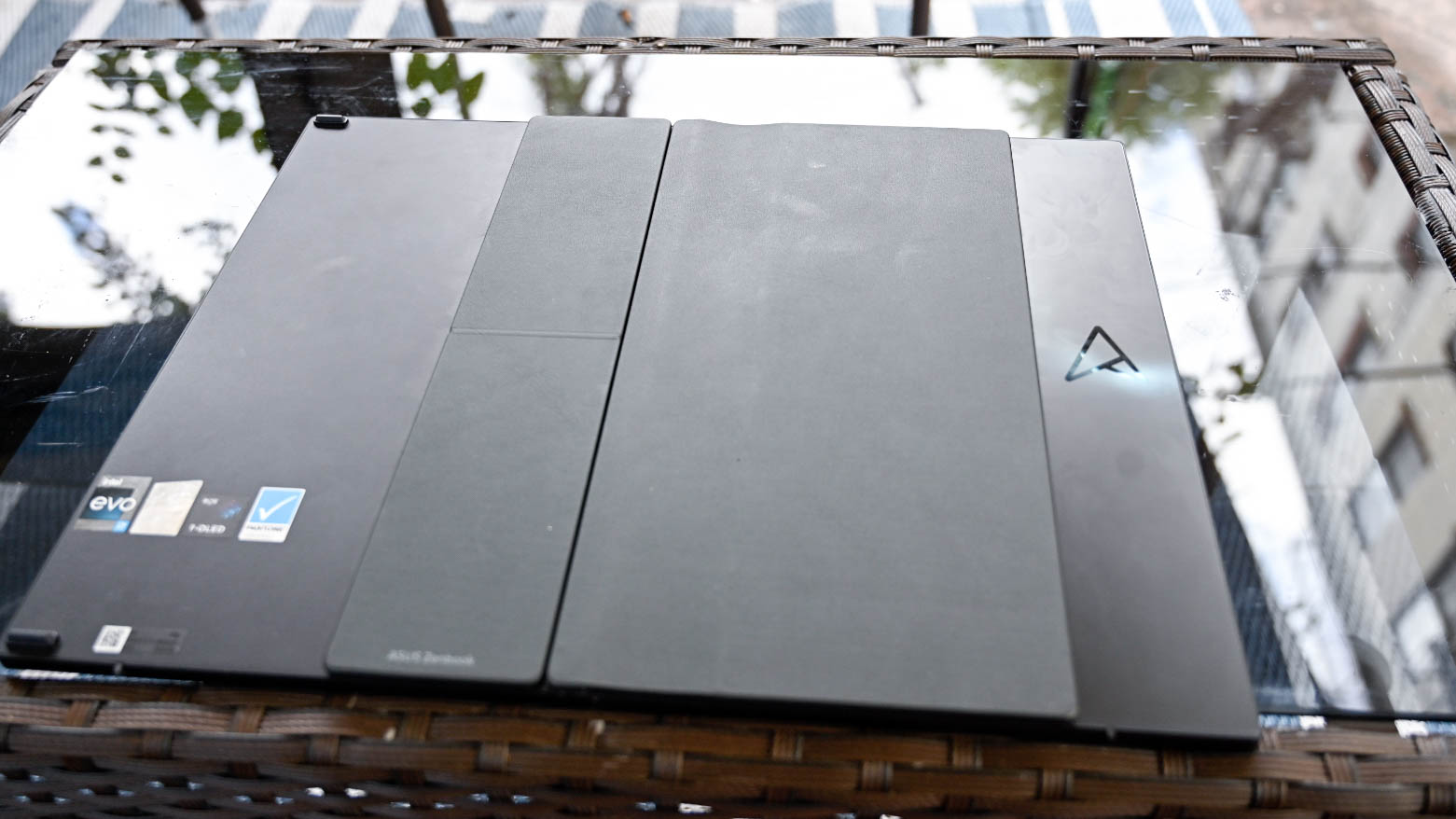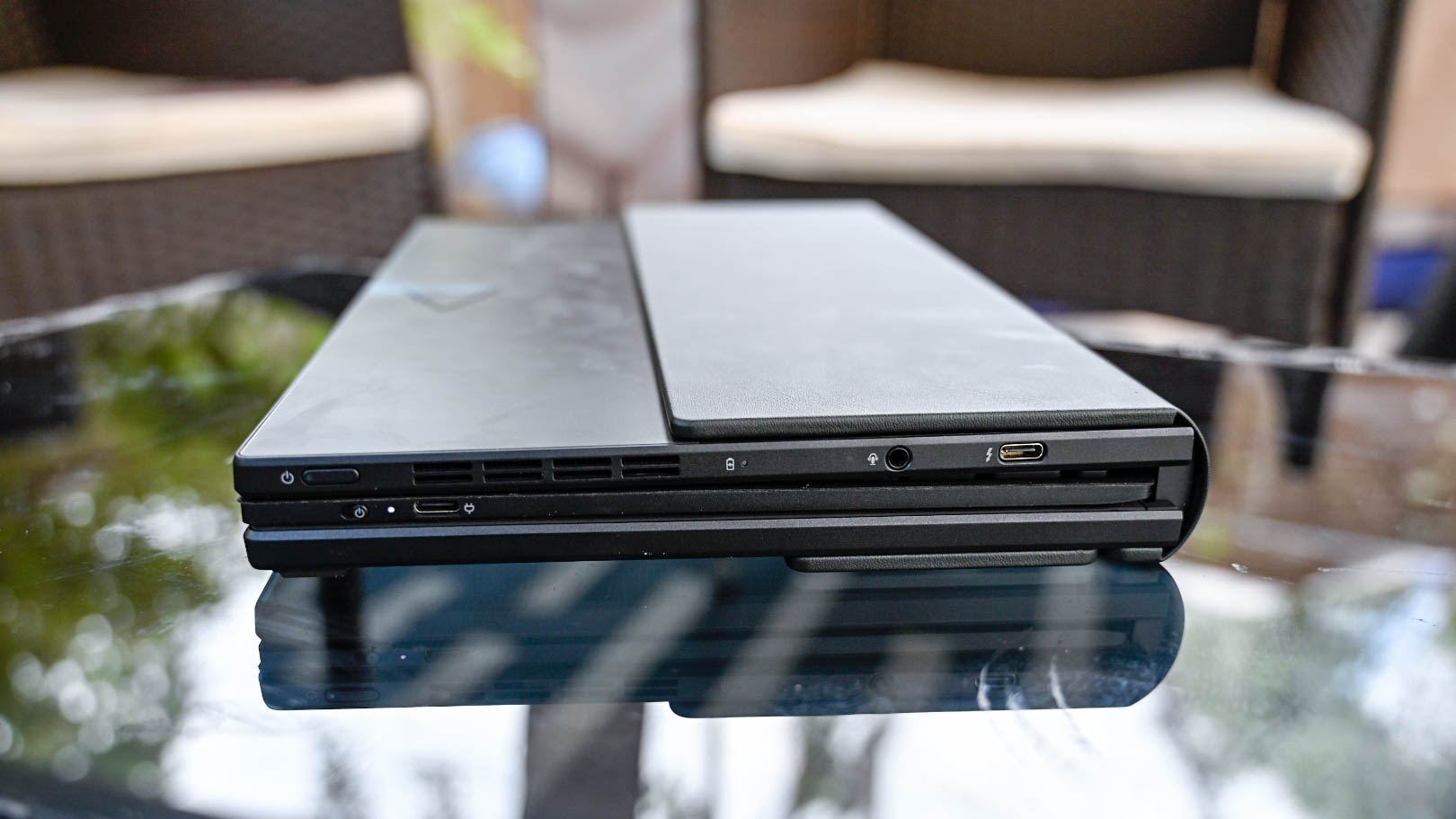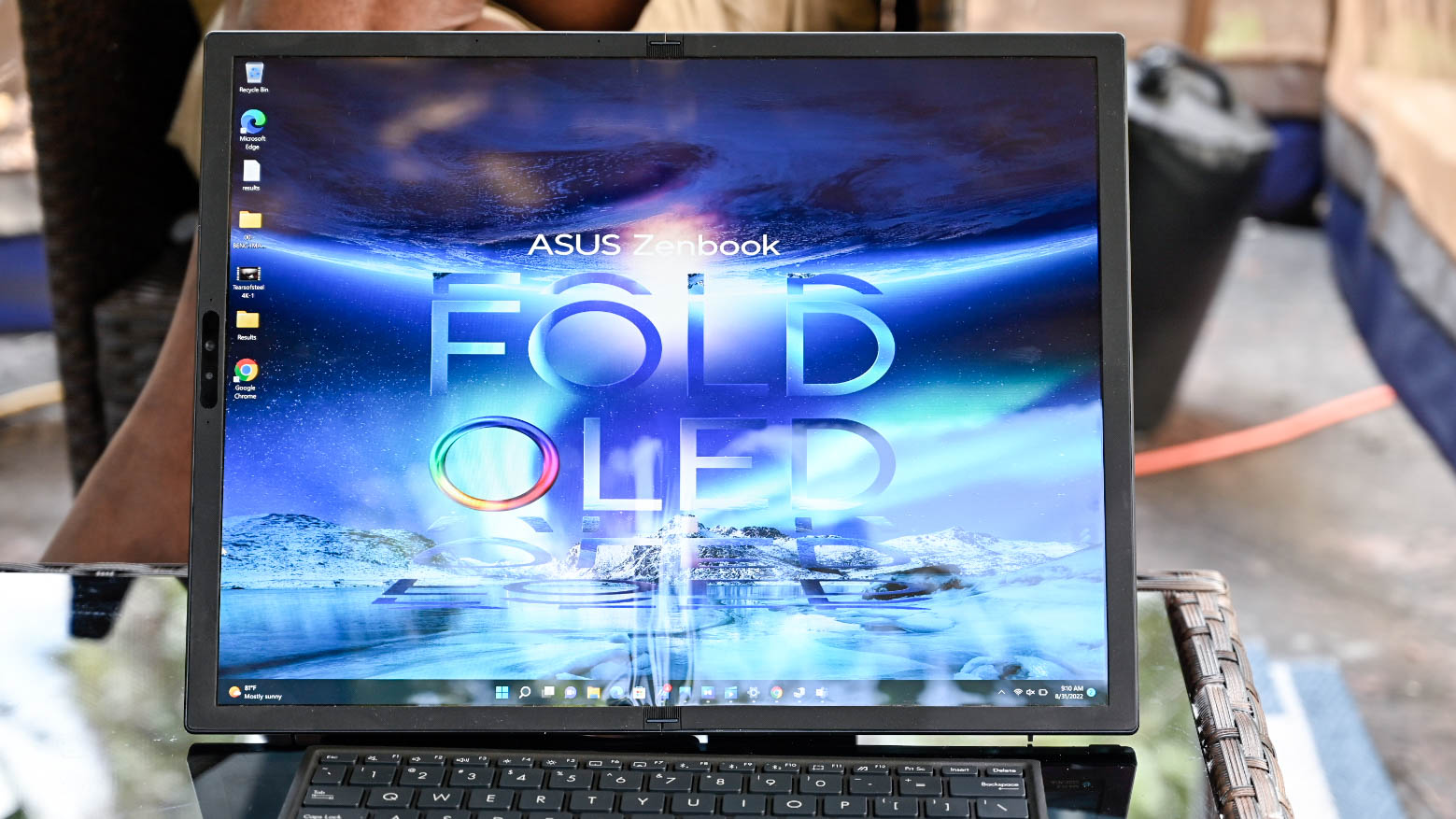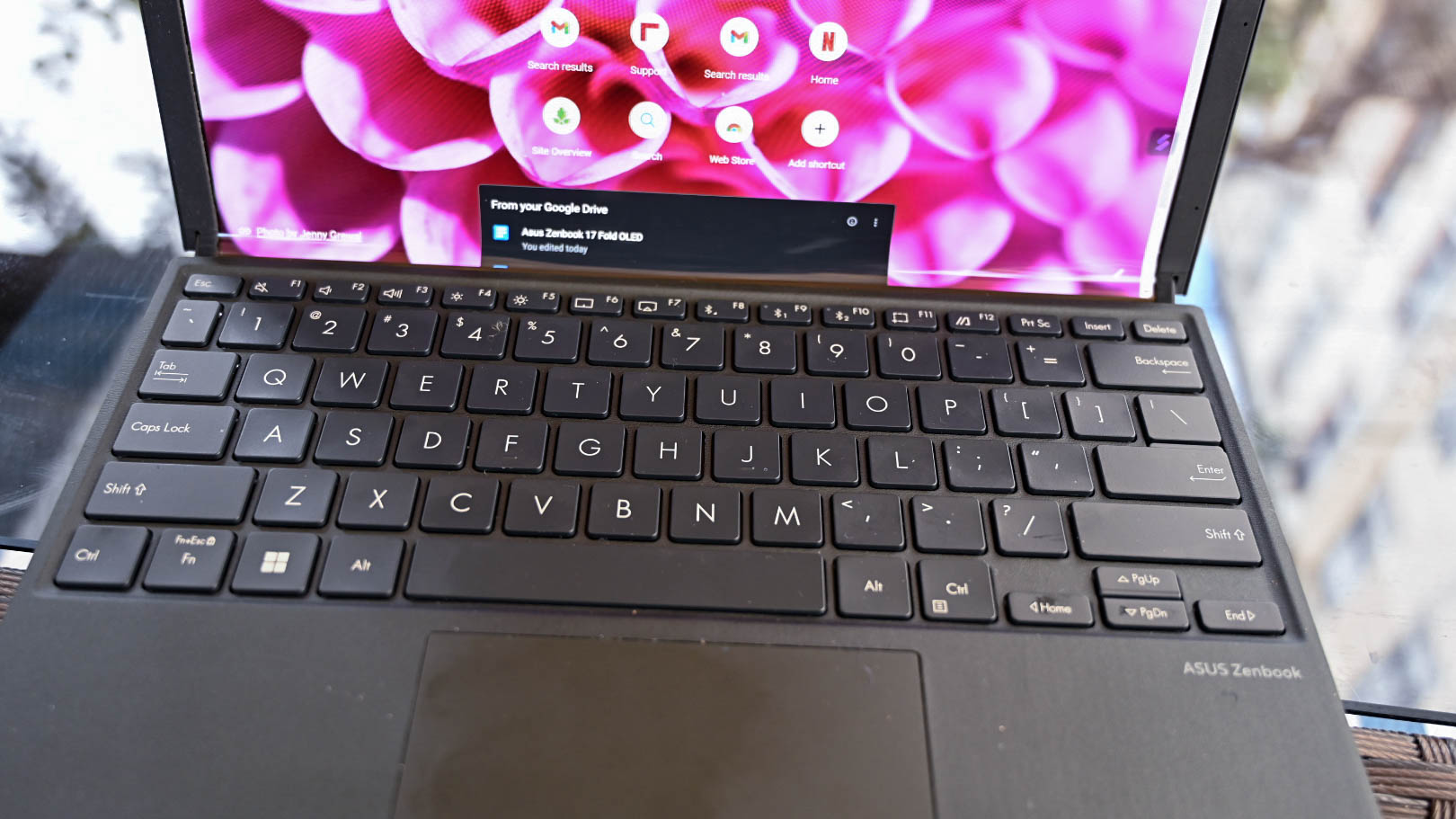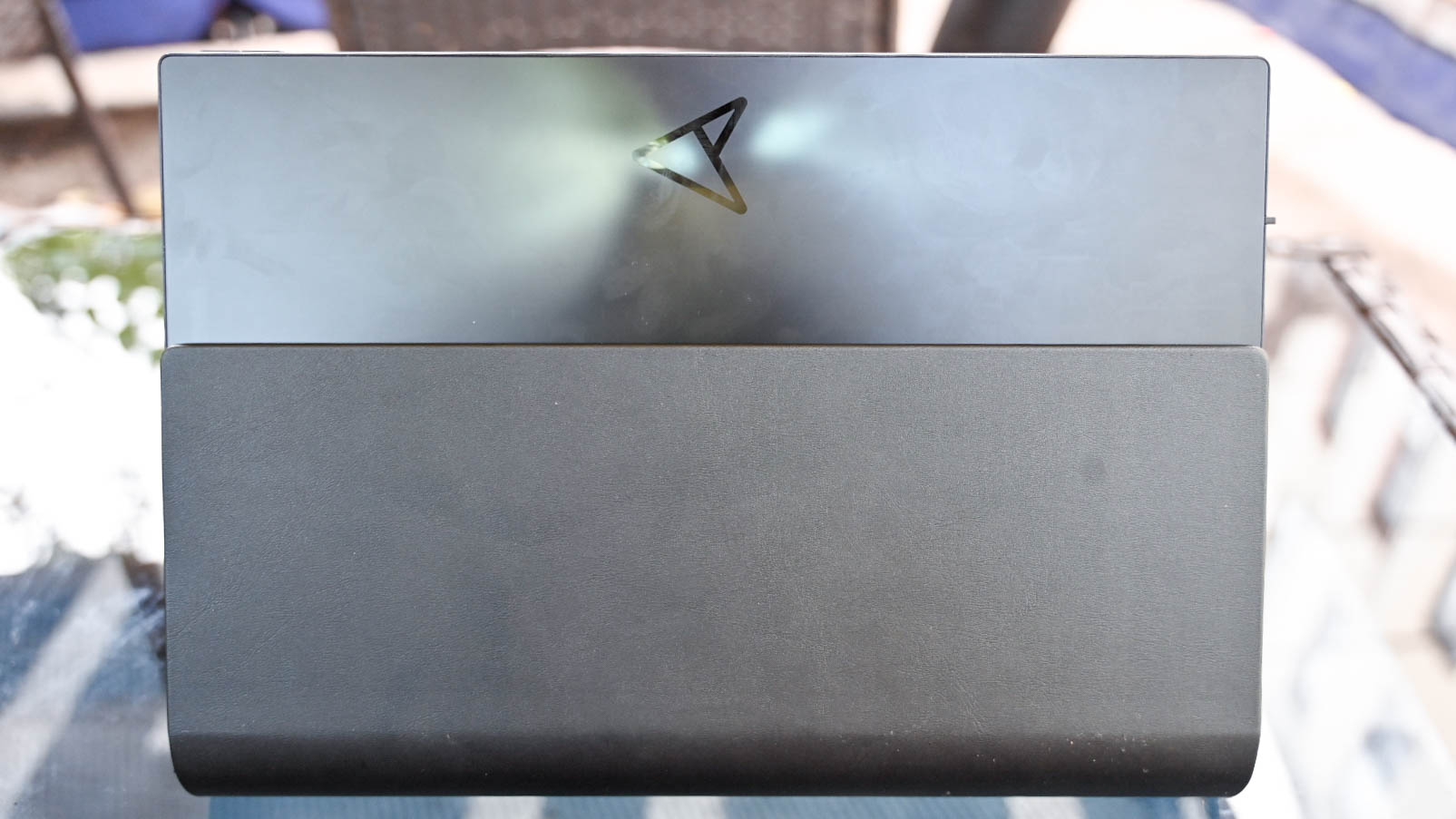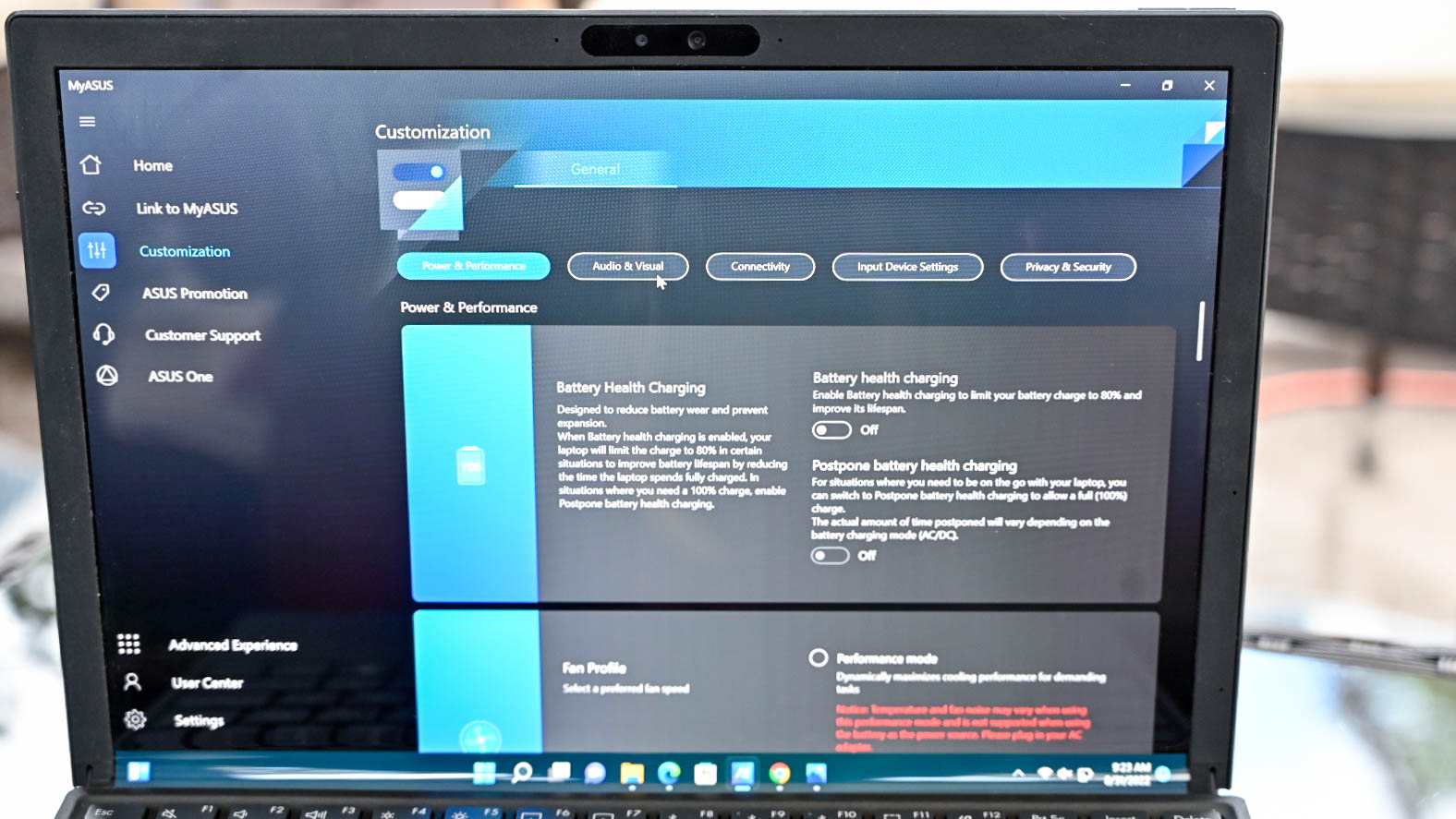Laptop Mag Verdict
With six easy-to-use modes, a lovely OLED display and Intel’s U-series graphics, the Asus Zenbook 17 Fold OLED is changing the way we think about laptops.
Pros
- +
Smart, versatile design
- +
Beautiful OLED display
- +
Easy-to-use modes
- +
Excellent webcam
- +
Solid performance
Cons
- -
Below-average battery life
- -
Only two Thunderbolt ports
- -
Expensive
Why you can trust Laptop Mag
It’s time to get bent – in a good way. After years of teasing, the world’s first foldable 17.3-inch laptop is here and there is plenty to like. The Asus Zenbook 17 Fold OLED is a multi-pronged solution to work and play thanks to Asus’ proprietary hinge and a foldable OLED display created by both Asus and Intel. Speaking of Intel, the Core i7 U-series processor is no slouch, delivering a surprising amount of power for a chip that’s known for its focus on power efficiency.
I had a blast using all of the modes, which thankfully aren’t gimmicky. And I definitely enjoyed the looks from friends and family alike as I went from watching movies on a huge tablet, to working on the couch to reading in the blink of an eye.
As much fun as I had bending the Fold to my whims, the $3,499 pricing hurts my wallet’s feelings, especially in such a financially sensitive climate. And for the price, I expect a few more ports and a pen for my troubles. Still, the Asus ZenBook 17 Fold OLED is a joy to use and I can unabashedly say welcome to the evolution of the laptop.
Asus Zenbook 17 Fold OLED pricing
As of this writing, there’s only configuration of the Asus Zenbook 17 Fold OLED and it costs an eye-watering $3,499. In addition to its 17.3-inch, foldable 2560 x 1920 OLED display you get a 3.5-GHz Intel Core i7-1250U processor with 16GB of RAM, a 1TB PCIe 4.0 x4 NVMe M.2 SSD and integrated Intel Iris Xe Graphics.
Asus Zenbook 17 Fold OLED design
Is it a ridiculously large tablet, a diminutive laptop or a stately e-reader? The answer is a little bit of everything and beyond. As the name suggests, the Fold does just that, transforming from a large display that can be used as a secondary screen or a Windows tablet into a laptop small enough to fit into a medium-sized laptop bag or backpack.
The majority of the Fold’s chassis is made up of magnesium alloy in a color that Asus has dubbed Tech Black. When the light hits the rear panel at just the right angle, the inky black seems to glow in a captivating green. Think of the bioluminescent bays found in parts of the Caribbean and you’re on the right track. A glossy, stylized “A” sits top center above the leather panel protecting the hinge. Along the bottom left of the leather, you’ll see the words Asus Zenbook. Give the strip a light pull to reveal the large kickstand.
Don’t be like me and almost destroy the machine because you think the entire leather panel is removable. It’s not. It’s a situation similar to the original Samsung Galaxy Fold, so pull gently and you should be fine. Rounding out the rear panel are two little feet to give the device a bit of lift when it’s in certain modes.
Sign up to receive The Snapshot, a free special dispatch from Laptop Mag, in your inbox.
Without the included Asus ErgoSense Bluetooth keyboard attached, the Fold’s front is all screen. The bezels are a bit thick, but they’re lined with a nice black soft-touch material. The top bezel holds a 5-megapixel webcam. The top of the detachable keyboard is done in leather and houses a full-sized keyboard in a slight recess with the keyboard sitting just below.
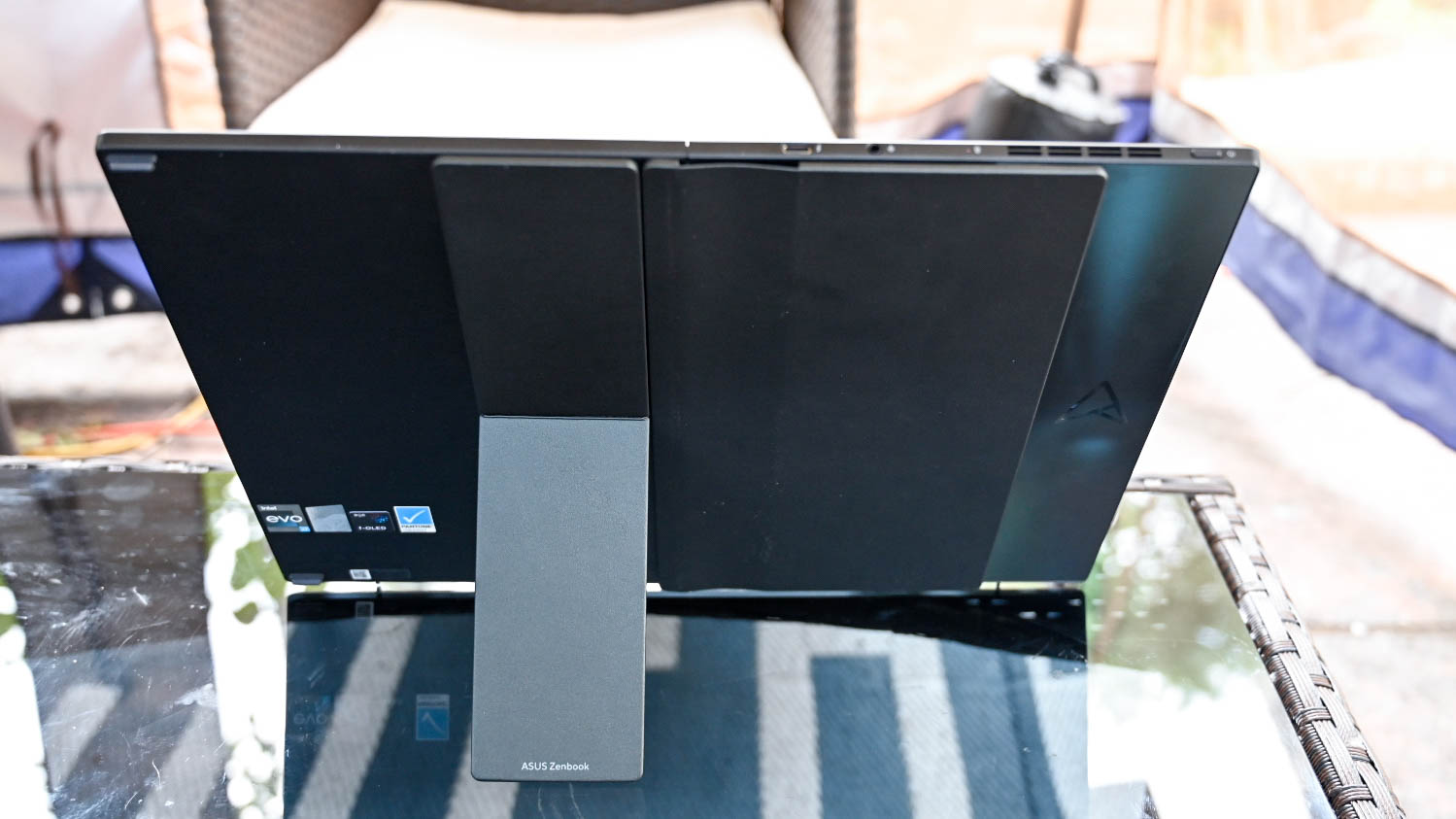
When it’s unfurled in Tablet or Desktop mode, the Fold weighs in at 3.3 pounds and measures 14.9 x 11.3 x 0.3~0.5 inches. It’s both bigger and heavier than the iPad Pro 12.9-inch (1.5 pounds, 11.04 x 8.46 x 0.3 inches). In Laptop mode, the Fold’s measurement shrinks to 11.3 x 7.5 x 0.7~1.4 inches and if you’re using the ErgoSense keyboard, the weight increases ever-so-slightly to 4 pounds. It makes the MacBook Air M2 (2.8 pounds, 12 x 8.4 x 0,6 inches) and the Dell XPS 13 Plus (2.7 pounds, 11.6 x 7.8 x 0.6 inches) seem light by comparison. Only the Lenovo Yoga 9i Gen 7 (12.52 x 9.06 x 0.6 inches) comes close to matching the Fold at 3.1 pounds.
Asus Zenbook 17 Fold OLED modes
Thanks to its hinge and bendable OLED panel, the Fold is capable of transitioning between six modes.
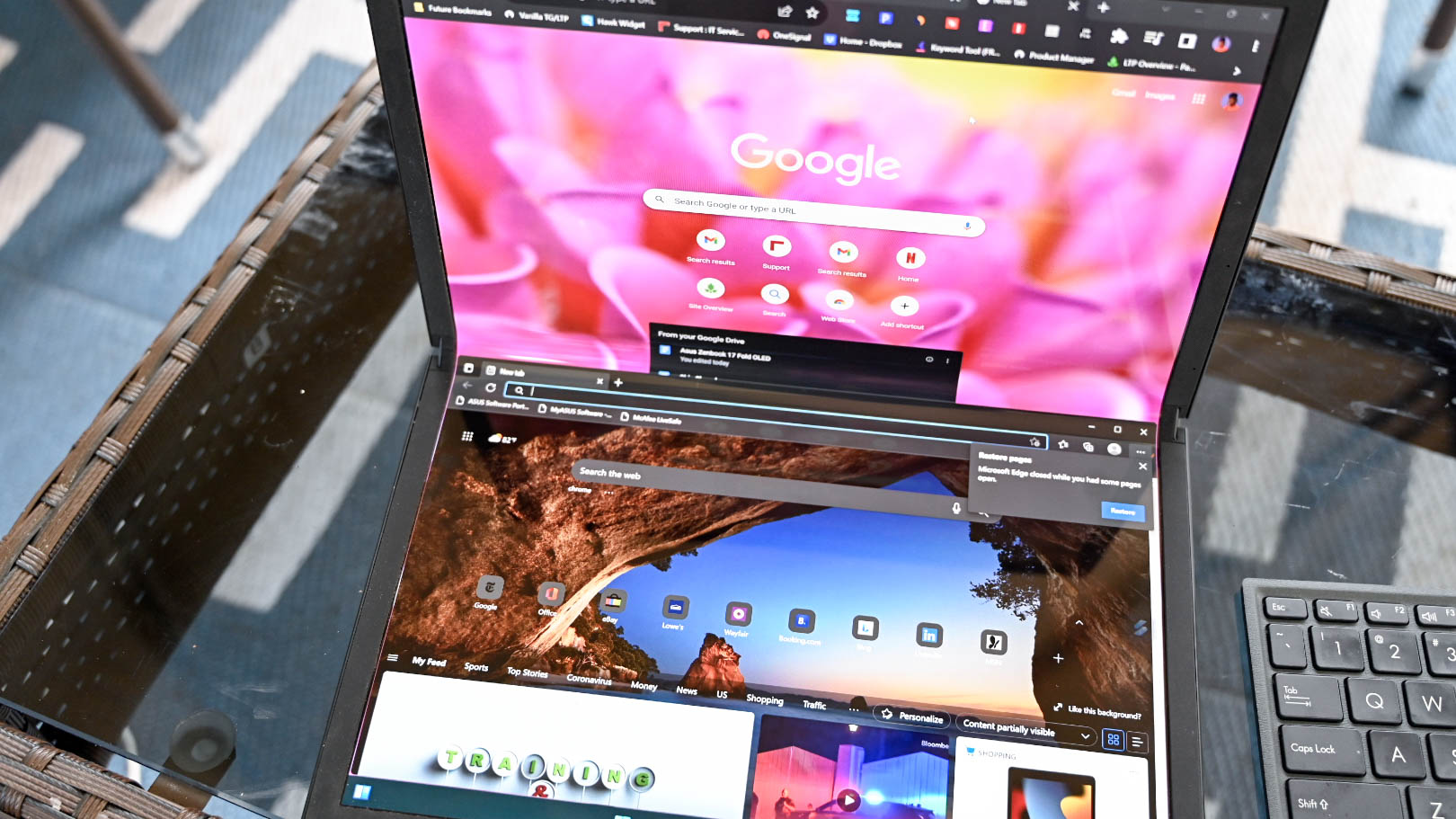
You have your traditional clamshell Laptop and Tablet modes, along with Reader mode in case you want to curl up with a good e-book. Desktop mode utilizes the integrated genuine leather kickstand on the back so the device can stand upright while you use the bundled Bluetooth keyboard just like you would with a regular monitor keyboard setup. If you need to multitask, there’s Extended mode which splits the Fold into a pair of 12.5-inch, 1920 x 1280 displays with a 3:2 aspect ratio. And finally, you have another Laptop mode (or laptop V as I like to call it). Where OG Laptop mode has you place the keyboard on the bottom portion of the Fold, Laptop Mode V offers a virtual keyboard.
Switching between the modes is fairly seamless, although I noticed that a lag of just under two seconds when changing the orientation. Everything else seemed near instantaneous.
Asus Zenbook 17 Fold OLED ports
Break out the dongles, because you’re definitely going to need them with the Zenbook 17 Fold as it only has two Thunderbolt 4 ports at the top left and right side of the convertible. The volume button occupies the top right corner with the power button located on the right side above a small vent. The headset jack sits next to the second Thunderbolt 4 port.
There’s a third Thunderbolt 4 port found on the right side of the Bluetooth keyboard. However, I imagine that you’ll be using that to charge the input device more than anything else. Next to the port is a small power switch.
Asus Zenbook 17 Fold OLED display
OLED. Just 17.3 inches of beautiful, bendable OLED display in all its vibrant glory. Like most foldables on the market, you can see the crease made from the hinge. But it’s not so pronounced that it distracts from the overall beauty of the panel, especially when you’re gazing at it head on in Tablet or Desktop mode. In those modes, you get the full experience of the 2.5K (2560 x 1920) resolution and its 4:3 aspect ratio.
I started my viewing journey on Netflix with an episode of David Attenbourough’s “Life in Color.” The detail was so sharp that I could see the tiny fissures in the sand-colored stone. Soon the screen was filled with the brilliant blue plumage of a peacock. And right before I got lost in the captivating sheen, the real show began as the tail feathers cascaded out, revealing the stunning eye spots amidst the wispy jade feathers.
When the convertible is in either of the Laptop modes the screen shifts to a 12.5-inch, 1920 x 1280 panel. In Extended mode, you get a pair of 12 inchers. I watched the trailer for “The Inspection” in Laptop mode and wondered how it was possible to make actor Gabrielle Union look like a normal person. Although her skin was its usual honey brown, there were acne marks on her cheeks with noticeable bags under her eyes. Meanwhile actor Jeremy Pope’s red hoodie popped against the pastel colored blanket.
When we measured the panel’s color accuracy, it measured 108.5% of the DCI-P3 gamut, surpassing the 90.5% premium laptop average. It also proved it was more vibrant than the MacBook Air (80%) and the XPS 13 Plus (84.2%). However, the Yoga was the most colorful with 140.1%.
In terms of color accuracy, the Fold comes out close to the top with a Delta-E score of 0.24 (0 is best). That’s better than the 0.25 category average as well as the Air (0.3) and the Yoga (0.39). But the XPS 13 Plus was the most accurate at 0.21.
Where the Fold falls flat is display brightness. The device averaged 323 nits on the brightness test, which is below the 428 nit average. The Lenovo, Dell and Apple hit 352, 366 and 386 nits, respectively.
But if the default display settings aren’t doing it for you, you can always fiddle around with the Asus Splendid utility in the MyAsus hub. In order to protect that beautiful OLED panel from burn-in, Splendid also has a pixel refresh feature and other OLED protecting goodies. From there, you can adjust the color temperature and gamut. Or you can use Dolby Vision, which offers three settings (Bright, Dark and Vivid).
The capacitive touch panel is fast and responsive. I just wish Asus thought to bundle a pen so I don’t have to mar the screen with my fingerprints, especially when you’re shelling out $3,499.
Asus Zenbook 17 Fold OLED audio
A chicken in every pot and a speaker in every corner. The Zenbook 17 Fold has a harmon/kardon speaker gracing every corner. That way, no matter how you’re using the Fold, you’ll have a full audio experience. Notice I said full, not good. Listening to Victoria Monét’s “Coastin’” I was disappointed at the tinniness on what’s usually a smooth bop.
I tried adjusting the audio with the preinstalled Dolby Atmos software. But no matter the setting (Music, Movie, Dynamic, Game or Voice) and their myriad of presets, the best I could get was only OK at best. My best result came from the Music setting with the Warm preset. The only bright spot is volume, which got loud enough to fill my smallish living and dining room.
Asus Zenbook 17 Fold OLED keyboard
When I first saw the ErgoSense keyboard, I was a little skeptical. In my experience, detachable keyboards like these tend to be flimsy, uncomfortable messes. But typing out the entirety of this review switching between Laptop and Desktop mode, I was pleasantly surprised at how comfortable the typing was.
The keys are large with a slight curvature and the key travel is deep enough where I never bottomed out. Plus, the keys are nice and clicky, not mechanical keyboard clicky, but still satisfying. I do wish there was some backlighting for when I wanted to work in my bedroom with the lights out.
But what the keyboard lacks in lighting it makes up with a few bells and whistles in the Fn row. There’s a key to launch MyAsus hub, which provides easy access to a host of helpful features. You’ll also find a trio of Bluetooth buttons. The F8 key handles Bluetooth management overall while the F9 and 10 keys let you switch quickly between two devices with the same keyboard. Asus also provides a screen capture key and a key that lets you determine how you want the display to respond when connected to another monitor. It can either act as its own screen, mirror the connected display or act as an extension.
But back to the typing experience. I easily reached 80 words per minute on the 10FastFingers typing test, sailing past my usual 70 wpm.
The 2.4 x 4.1-inch touchpad is smooth to the touch. It’s agile and reactive and easily performs Windows 11 gestures.
While I like using the keyboard in Desktop mode, I prefer Laptop mode with the keyboard. There’s something about how the panel switches from a massive panel to an ultraportable as soon as the keyboard touches it that does it for me. Asus has rated the keyboard for an estimated 24 hours of battery life. I’ve used it for nearly 3 days straight and have yet to run out of juice.
Asus Zenbook 17 Fold OLED performance
The Zenbook 17 Fold OLED is powered by a 1.1-GHz Intel Core i7-1250U processor with 16GB of RAM and a 1TB PCIe 4.0 x4 NVMe M.2 SSD. U-series chips are focused on power efficiency and are typically found in 2-in-1 laptops. And now it lends its power to the growing foldable market. A hybrid chip, the CPU consists of two performance cores and eight efficiency cores. According to Intel, the Performance cores or P-cores are designed to handle compute-heavy loads like gaming while the Efficiency cores (E-Cores) are there for all your multitasking needs.
The Fold allowed me my usual menagerie of 65 Google Chrome tabs which includes a mix of Google Docs, Sheets and Sidess along with a YouTube video or two, Tweetdeck, Facebook and a host of news sites and analytic trackers. The foldable kept plugging along without a hint of lag.
The Asus foldable also stood its ground during our synthetic tests, starting with Geekbench 5.4, our overall performance test where the system posted 7,098. It handily defeated the 5,942 premium laptop average. However, faced with more powerful processors, there is a notable difference. The Yoga, for example, with its Intel Core i7-1260P CPU reached 7,150 while the XPS 13 Plus (Intel Core i7-1280P CPU achieved 10,621. The MacBook Air’s M2 chip scored 8,919.
During the Handbreak video transcoding test, the Fold converted a 4K video to 1080p in 14 minutes and 16 seconds, which is slower than the 9:50 average, The Yoga, XPS 13 Plus and MacBook Air posted times of 12:18, 8:17 and 7:52, respectively.
On the File Transfer test, the Fold’s SSD duplicated 25GB of mixed-media files at a rate of 1,480.3 megabytes per second, scorching the 1,142.3 category average. Both the Dell (1,502.1MBps, 512GB M.2 PCIe NVMe Gen 4 SSD) and the Lenovo (1,506.9MBps, 1TB SSD) obtained faster results.
Asus Zenbook 17 Fold OLED graphics
I’m still not sold on integrated graphics as a true gaming solution, but the Fold gave me a reason to perhaps reconsider that stance. We ran the Sid Meier’s Civilization VI benchmark and the Zenbook 17 Fold OLED’s Intel Iris Xe Graphics GPU reached 50 frames per second at 1080p, matching the premium laptop average while topping the XPS 13 Plus and Yoga with their own Iris Xe Graphics both got 23 fps.
When we ran the test on the Fold’s native settings, it reached 68 fps while the XPS 13 Plus and Yoga only reached 15 and 14 fps.
Asus Zenbook 17 Fold OLED battery life
Asus outfitted the Zenbook 17 Fold with a 75W battery lithium-polymer battery, which when paired with Intel Evo certification (nine hours or more of battery life on FHD displays and four hours or more of charge in 30 minutes) should provide for solid battery life. But OLED and a higher resolution has a way of derailing the best laid plans.
When we ran the Laptop Mag Battery test, the Asus Zenbook 17 Fold OLED lasted 7 hours and 56 minutes, falling short of the 9:54 premium laptop average while surpassing the XPS 13 Plus’ 7:35. The Yoga lasted a bit longer at 8:06 while the MacBook Air ran the victory lap at 9:31.
Asus Zenbook 17 Fold OLED webcam
Just on color alone, the Zenbook 17 Fold OLED’s 5MP webcam is one of the best I’ve seen. Not only did it accurately capture my red-and-white dress, it also got all the colors in my locs. Now, it definitely blew out the white wall in the background, but it also did a good job of not turning the white flowers on my dress into blobs.
The excellent color is due to the integrated color sensor which uses ambient light levels to automatically adjust the brightness and color temperature for the best image.
But the webcam really comes into its own during video conferencing. With snazzy features such as Lighting Optimization, Background Blurring, Eye Tracking, and Motion Tracking – all of which can be found in the MyAsus app. The camera also makes use of Asus’ proprietary 3D Noise Reduction technology that sharpens images and eliminates that pesky visual noise in real time.
Asus Zenbook 17 Fold OLED software
Aside from Dolby Access and Microsoft apps, the Zenbook 17 Fold is delightfully free of third-party software. Instead, you have several Asus-branded apps designed to help you get the most out of your shiny new foldable. We’ve gone over MyAsus which is your one-stop shop for a host of settings covering audio, visual, connectivity and security. It’s also where you can reach a tech support agent should trouble arise.
Asus also included GlideX, a screen-sharing solution designed to make it easier to create a larger work (or play) space. It enables screen mirroring between the Fold and Android and iOS devices wirelessly or via USB. You can also extend the screen, allowing you to drag and drop content between devices. While there is a free version of GlideX, there are monthly subscriptions starting at $0.99 (Plus) that tops out at $5.99 (Ultra).
The difference in the plans lies in connection and streaming quality. The free version only offers a wired connection and 720p streaming. Plus, there are ads. The $0.99 iteration allows both wired and wireless connections and strips ads. The Ultra version throws in streaming at 1080p and 2K.
The Asus Zenbook 17 Fold OLED ships with a 1 year limited warranty. See how Asus fared during Tech Support Showdown and Best and Worst Brands, our annual special reports.
Bottom line
It’s tough being first. You set yourself as the bar for the industry standard. And with nothing to compare against, there’s a high risk of failure. You won’t find that with the Asus Zenbook 17 Fold OLED. It’s an elegant conversation starter, drawing all the oohs and ahhs as it transforms from a ginormous tablet to a dainty laptop. But most importantly, it’s easy to use. Like a lump of clay, you can bend and shape the Fold into whatever you need it to be for work or play. Need to bang out a paper? Try Laptop or Desktop Mode. Want to watch movies? Bask in the OLED goodness in tablet mode. Gotta multitask? Try Extended mode or connect a monitor, smartphone or tablet. Hell, you can even use it to curl up with a book.
The U-series processor is more powerful than it has any right to be and the same goes for the integrated graphics.
However at $3,499, which is definitely an innovation and first-at-bat tax, I definitely wanted a few more ports and a pen. Also, the battery life could definitely be better. The price is definitely a deterrent when you can get a fully tricked-out M2 MacBook Air for $1,000 cheaper.
But if you want to play with the future right now, you can’t pass up the Asus ZenBook Fold.

Sherri L. Smith has been cranking out product reviews for Laptopmag.com since 2011. In that time, she's reviewed more than her share of laptops, tablets, smartphones and everything in between. The resident gamer and audio junkie, Sherri was previously a managing editor for Black Web 2.0 and contributed to BET.Com and Popgadget.
